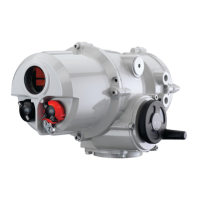Having established that the Primary
Functions have been correctly set, the
Secondary Functions can now be
configured to suit site control and
indication requirements.
It is possible to move through the
various Secondary Functions as shown
in Fig. 9.1 using the
O
and Q keys.
The actuator wiring diagram will
indicate any options fitted.
Options Setting Tool Local Control [Or]
and Power Loss Inhibit [OS] are
standard features, their use being
optional.
In order to display the Secondary
Functions it is necessary to press the
Qkey until [Cr] appears.
If you have chosen to enter Secondary
Functions in the checking mode the
display will be as Fig. 9.2.
If you have chosen to enter Secondary
Functions in the setting mode the
display will be as Fig. 9.3 (refer to
Section 7).
Fig. 9.2 Fig. 9.3
PRESS THE O KEY.
27
9.1
SECONDARY FUNCTIONS CONTENTS
page
9.0 Commissioning Secondary Functions 25
9.1 Accessing the Secondary Settings 27
9.2 Indication Contacts S1, S2, S3 and S4 28
9.3 Control Mode Configuration 30
9.4 Option Extra Indication Contacts S5–S8 33
9.5 Option CPT (Current Position Transmitter) 34
9.6 Option Folomatic Remote Control 35
9.7 Remote Control Source 38
9.8 Bus System Option Pakscan 39
9.9 Bus System Option Modbus 43
9.10 Bus System Option Profibus DP 47
9.11 Bus System Option DeviceNet 51
9.12 Bus System Positioning Control Settings 54
9.13 Option Interrupter Timer 56
9.14 Setting Tool Local Control 58
9.15 Inhibit Operation After Power Loss 58
9.16 Actuator Type Setting 59
9.17 Default Options 60
9.18 Default Options 61
10.0 Maintenance,Monitoring and Troubleshooting 62
10.1 Help Screens 64
10.2 IrDA Diagnostics and Configuration 69
Accessing the
Secondary Functions

